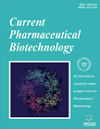- Home
- A-Z Publications
- Current Pharmaceutical Biotechnology
- Previous Issues
- Volume 10, Issue 7, 2009
Current Pharmaceutical Biotechnology - Volume 10, Issue 7, 2009
Volume 10, Issue 7, 2009
-
-
Chlorophytum borivilianum: A White Gold for Biopharmaceuticals and Neutraceuticals
More LessChlorophytum borivilianum Santapau & Fernandes (Liliaceae) also known as ‘Safed Musli’ is a traditional rare Indian medicinal herb which has many therapeutic applications in Ayurvedic, Unani, Homeopathic and Allopathic systems of medicine. Its roots (tubers) are widely used for various therapeutic applications. It is used to cure physical illness and weakness, as an aphrodisiac agent and revitalizer, as general sex tonic, re Read More
-
-
-
Momordica balsamina: A Medicinal and Neutraceutical Plant for Health Care Management
More LessMomordica balsamina, African pumpkin (Cucurbitaceae), is a tendril-bearing, wild climber containing wide spectrum of medicinal and nutritional values and has been used as a traditional folk medicine in many countries. The leaves, fruits, seeds, and bark of the plant contain resins, alkaloids, flavonoids, glycosides, steroids, terpenes, cardiac glycoside, saponins having various medicinal importance viz. anti-HIV, anti-plasmodial, Read More
-
-
-
Clinical Applications of Creatine Supplementation on Paediatrics
More LessCreatine plays a central role in energy metabolism and is synthesized in the liver, kidney and pancreas. In healthy patients, it is transported via the blood stream to the muscles, heart and brain with high and fluctuating energy demands by the molecule creatine transporter. Creatine, although naturally synthesized in the human body, can be ingested in the form of supplements and is commonly used by athletes. The purpose of Read More
-
-
-
Efficient Production of Gossypol from Hairy Root Cultures of Cotton (Gossypium hirsutum L.)
More LessA protocol for induction and establishment of Agrobacterium rhizogenes mediated hairy root culture of Gossypium hirsutum was developed through infection with the A4 strain and co-cultivation on hormone-free semi-solid MS medium with B5 vitamins. It resulted in the emergence of hairy roots from the leaf explants, 21 days after infection. The transformation of hairy roots was established by PCR amplification of rol B and rol C Read More
-
-
-
Comparative Binding Analysis of Monoclonal Antibodies Against Native and Mutant Type in ErbB2 Receptor: A Theoretical Modeling Approach
More LessAuthors: R. Rajasekaran and Sethumadhavan RaoTrastuzumab and pertuzumab are monoclonal antibodies, used for inhibiting the ErbB2 receptor which is over expressed in breast and ovarian cancer. In this study, we identified that the most detrimental single point mutation is from tryptophan to cysteine at the residue position of 452 on ErbB2 receptor by using I-Mutant 2.0, SIFT and PolyPhen programs. The modeled mutant showed less stability than native ErbB2 protein Read More
-
-
-
Evaluation of ISCOMs for Immunization Against Hepatitis B
More LessAuthors: R. S. Pandey and V. K. DixitImmune stimulating complexes (ISCOMs) incorporating recombinant hepatitis B surface antigen (rHBsAg) were prepared for induction of humoral and cellular immunity by subcutaneous administration. Prepared ISCOMs were characterized for their size, shape, incorporation efficiency, zeta potential, antigen integrity, antigen conformation and immunogenicity by biophysical and immunological techniques including transmissi Read More
-
Volumes & issues
-
Volume 26 (2025)
-
Volume 25 (2024)
-
Volume 24 (2023)
-
Volume 23 (2022)
-
Volume 22 (2021)
-
Volume 21 (2020)
-
Volume 20 (2019)
-
Volume 19 (2018)
-
Volume 18 (2017)
-
Volume 17 (2016)
-
Volume 16 (2015)
-
Volume 15 (2014)
-
Volume 14 (2013)
-
Volume 13 (2012)
-
Volume 12 (2011)
-
Volume 11 (2010)
-
Volume 10 (2009)
-
Volume 9 (2008)
-
Volume 8 (2007)
-
Volume 7 (2006)
-
Volume 6 (2005)
-
Volume 5 (2004)
-
Volume 4 (2003)
-
Volume 3 (2002)
-
Volume 2 (2001)
-
Volume 1 (2000)
Most Read This Month
Article
content/journals/cpb
Journal
10
5
false
en


